Agrisera participates and supports several conferences in 2026
Agrisera will participate in the following meetings in 2026:• The 39th Conference Molecular Biology of Plants of the Section Plant Physiology and Molecular Biology, 16th-19th of March, Hennef, Germany• The 7th International Plant Protease Conference, 31st of May -4h of June, Sigtuna, Sweden • International Conference on Arabidopsis Research (ICAR), 22nd-26th of June, Singapore • Plant Biology 2026 (ASPB), 18th-22nd of July, Ottawa, Canada • International Conference on Photosynthesis Research, Liverpool, 26th-30ies of July, United Kingdom • International Conference of German Society of Plant Biology, 6th-10th of Septemeber, Bochum, Germany • 2nd Plant Meiosis Meeting, 9th-11th of September, Poznań, Poland • KBC Days 2026, November, Umeå University, Sweden Agrisera supports the following meetings in 2026:• 35th Western Photosynthesis Conference, 7th-9th of January, Los Gatos, USA |  In The Global Plant Science Events Calendar, you will find the most up-to-date information about worldwide conferences, congresses and even online events. This community resource celebrates its 7th anniversary in January 2026. |

















































